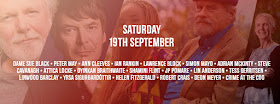This year’s Ned Kelly Crime Awards entries are testimony to the strong increase in crime reading and crime writing, despite a challenging year for book publishing and retailers due to the COVID-19 pandemic.
Australian Crime Writers Association chair Robert Goodman said the large number of entries in this year’s awards demonstrates that Australian crime writing and reading has never been stronger.
‘This is not just evident in the number of submissions but the diversity and quality of the entries. Congratulations to all our entry authors.’
‘Fiction entries include page turning thrillers, police procedurals, lone detectives and dirty dealings with many fascinating characters across a range of vividly portrayed settings.’ Goodman said.
This year, for the first time, the Ned Kelly Awards also include a category for Best International Crime Fiction published in Australia, adding to the regular categories of Best Crime Fiction, Best Debut Crime Fiction and Best True Crime.
‘It is exciting to be able to recognize not only our incredible home grown talent but also some of the world’s top international crime authors,’ Goodman said.
BEST CRIME FICTION
The 2020 shortlist for the Ned Kelly Awards headline category, Best Crime Fiction features: Death of a Typographer, by Nick Gadd, a ‘quirky and original story which is funny and very Melbourne’; The Strangers We Know, by Pip Drysdale, a ‘conspiratorial well-paced read that keeps you glued to the page’; The Scholar, by Dervla McTiernan, ‘an elegant and tightly constructed read with depth and excellent characterisation’; The Wife and the Widow, by Christian White, is ‘cleverly plotted with a major plot twist threaded extremely well through the action’; River of Salt, by Dave Warner, is an ‘evocative tale about the Australian surf scene in the early 1960s with compelling characters’; and True West, by David Whish-Wilson, is a book with ‘a distinct sense of time and place where you can almost smell the outback’.
BEST DEBUT CRIME FICTION
The Debut Crime Fiction shortlist covers a diverse range including Eight Lives, by Susan Hurley, an ‘original medical thriller viewed through the lens of the migrant experience’; Where the Truth Lies, by Karina Kilmore, is ‘a great read with an interesting new setting and good twists’; Lapse, by Sarah Thornton, is ‘atmospheric rural crime with well-drawn characters’; The Nancys, by RWR McDonald, is ‘full of quirky characters and pays homage to Nancy Drew’; Six Minutes, by Petronella McGovern, considers ‘the nightmare scenario of a missing child’; and Present Tense, by Natalie Conyer, ‘has a great setting, complex taut plot and flawed characters’
BEST TRUE CRIME
This year’s True Crime shortlist includes Dead Man Walking: The murky world of Michael McGurk and Ron Medich by Kate McClymont which has a cast of true characters to rival any fiction novel; Bowraville, by Dan Box, addresses themes of endemic racism and justice as well as the ethics of true crime reporting; Shark Arm, by joint authors Phillip Rooper and Kevin Meagher, centres on an old but almost forgotten tale retold with great research and powerful writing; and Snakes and Ladders, by Angela Williams, about a young mother’s experience of addiction, recovery and serving time clean.
BEST INTERNATIONAL CRIME FICTION
The new Ned Kelly Award for international crime fiction included submissions from some of the world’s biggest-selling crime fiction authors and the shortlist has been narrowed down to: The Night Fire by US author Michael Connelly, The Last Widow by US author Karin Slaughter, The Chain by Irish author Adrian McKinty and Cruel Acts by Irish author Jane Casey.
ABOUT THE NED KELLY AWARDS
The Ned Kelly Awards are Australia’s oldest and most prestigious prizes for crime fiction and true crime writing. First established in 1995 and now in their twenty-fifth year, previous winners include: Peter Temple, Shane Maloney, Gabriel Lord, Candice Fox, Garry Disher, Helen Garner and Duncan McNab.
2020 Ned Kelly Awards Shortlists
BEST CRIME FICTION:
Death of a Typographer by Nick Gadd (Australian Scholarly Publishing)
The Strangers We Know by Pip Drysdale (Simon & Schuster Australia)
The Scholar by Dervla McTiernan (Harlequin Enterprises Australia)
The Wife and the Widow by Christian White (Affirm Press)
Rivers of Salt by Dave Warner (Fremantle Press)
True West by David Whish-Wilson (Fremantle Press)
BEST DEBUT CRIME FICTION:
Present Tense by Natalie Conyer (Clan Destine Press)
Eight Lives by Susan Hurley (Affirm Press)
Where the Truth Lies by Karina Kilmore (Simon & Schuster Australia)
The Nancys by RWR McDonald (Allen & Unwin)
Six Minutes by Petronella McGovern (Allen & Unwin)
Lapse by Sarah Thornton (Text Publishing)
BEST TRUE CRIME:
Bowraville by Dan Box (Penguin Random House Australia)
Dead Man Walking: The murky world of Michael McGurk and Ron Medich by Kate McClymont (Penguin Random House Australia)
Shark Arm by Phillip Rooper and Kevin Meagher (Allen & Unwin)
Snakes and Ladders by Angela Williams (Affirm Press)
BEST INTERNATIONAL CRIME FICTION:
Cruel Acts by Jane Casey (Harper Collins Australia)
The Night Fire by Michael Connelly (Allen & Unwin)
The Chain by Adrian McKinty (Hachette Australia)
The Last Widow by Karin Slaughter (Harper Collins Australia)



















